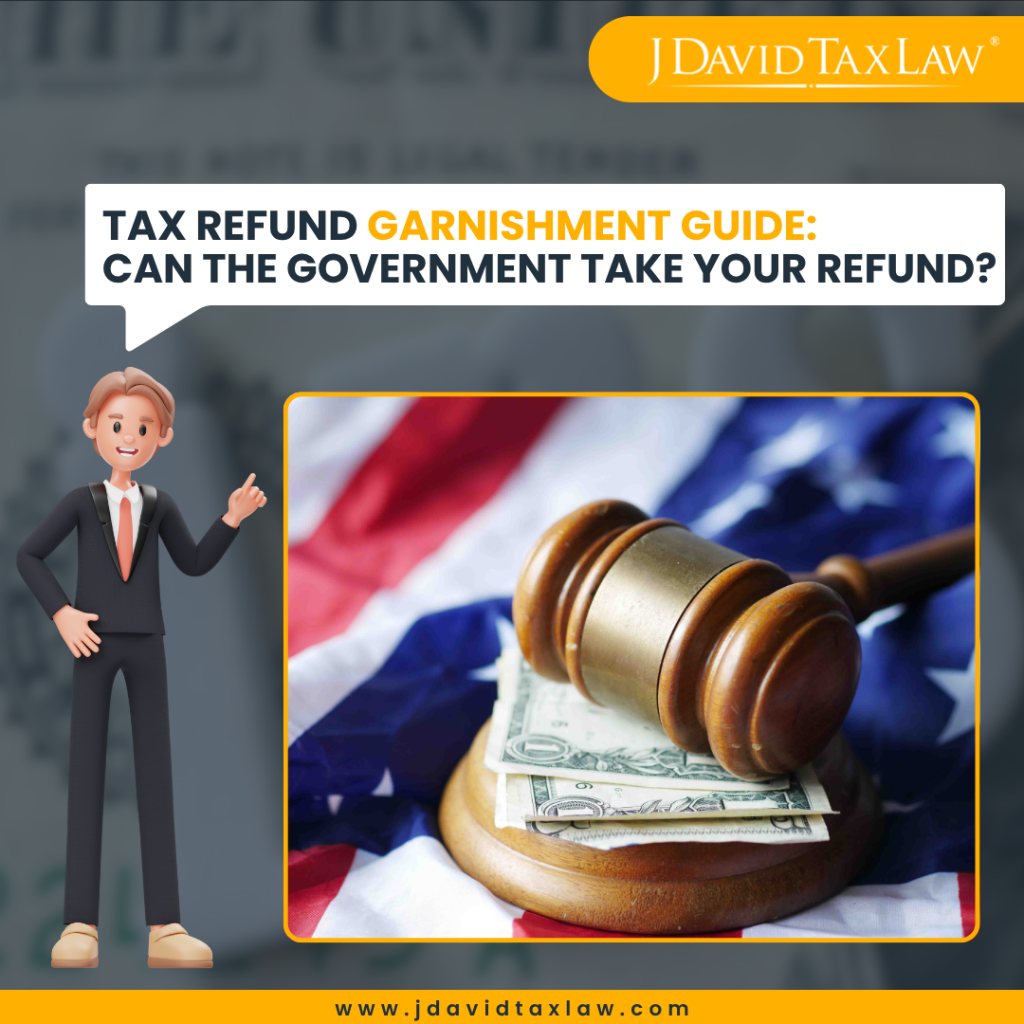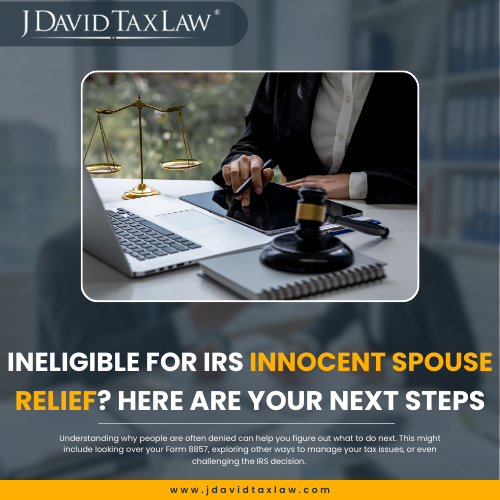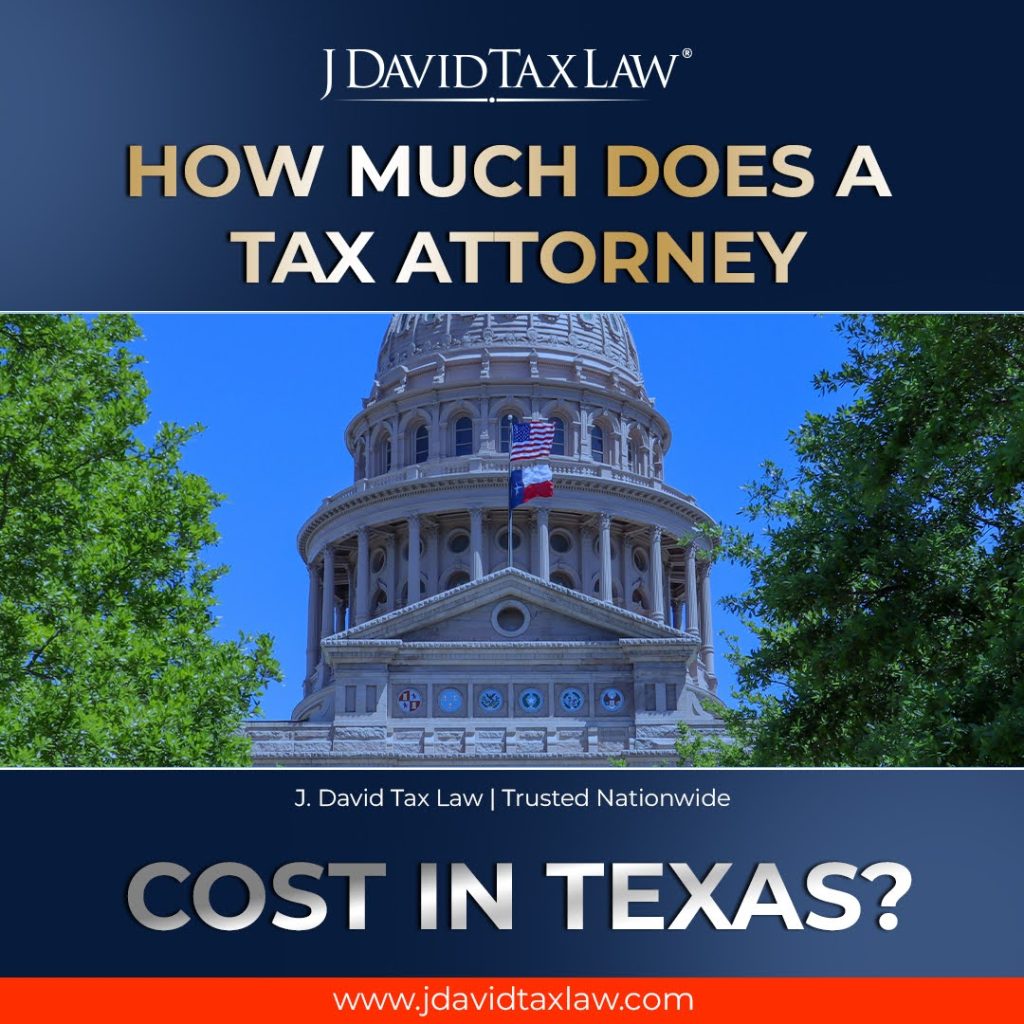Every year, millions of Americans look forward to their tax refund only to discover it’s been partially or fully seized without warning. This isn’t a glitch. It’s called a tax refund offset , and it often comes as a shock.
Many taxpayers assume the IRS controls everything about their refund, but that’s not the whole picture. In reality, other agencies, including state governments and federal departments, can legally seize your refund to satisfy a wide range of debts, often through a program you’ve never heard of.
Understanding your rights under the Treasury Offset Program (TOP) is the first step. This federally authorized system allows the government to garnish your tax refunds for overdue child support, defaulted student loans, unpaid unemployment insurance contributions , and more — all without court approval.
J David Tax Law helps clients fight back fast . Whether your refund was garnished improperly, or you’re entitled to relief, our attorney-only team will investigate the source, challenge the debt when possible, and help recover what’s rightfully yours.
What Is a Tax Refund Garnishment?
A tax refund garnishment is a federal collection mechanism through which the U.S. Department of the Treasury applies part or all of an individual’s tax refund toward unpaid government debts. Most people refer to this as “tax refund garnishment”, but the official term used by the IRS and U.S. Treasury is refund offset. It’s a powerful tool that allows federal and state agencies to seize your refund without a court order.
According to IRS Topic No. 203, Reduced Refund, a refund offset occurs when the Bureau of the Fiscal Service (BFS), under the Treasury Offset Program (TOP ), reduces your federal tax refund to pay:
-
Past-due child support
-
Delinquent federal student loans or agency debts
-
State income tax debts
-
Certain unemployment compensation overpayments
These debts are submitted by other government agencies, not by the IRS itself, and the refund is garnished before you ever receive it.
Why It Catches People Off Guard
The IRS does not send advance warnings about offsets on behalf of other agencies. If your refund is reduced, you’ll receive a notice after the fact from the BFS, listing:
-
The original refund amount
-
The amount taken
-
The agency that received the funds
-
Contact details for that agency
If you’re not expecting it, a refund offset can come as a shock. That’s why it’s critical to know who can take your refund, and how to check before filing.
The IRS is Forgiving Millions Each Day. You Could Be Next.
Who Can Take Your Tax Refund?
Not all debts can lead to a refund offset, but several government agencies have the legal authority to garnish your federal tax refund if you owe certain types of qualifying obligations.
|
Authority |
Type of Debt Collected |
Legal Program or Statute |
|
State Child Support Agencies |
Past-due child support obligations |
Social Security Act § 464, 42 U.S.C. § 664 |
|
U.S. Department of Education |
Defaulted federal student loans |
Higher Education Act of 1965 |
|
State Tax Agencies |
Past-due state income taxes |
State Revenue Laws + TOP |
|
State Workforce Agencies |
Fraudulent unemployment overpayments or unpaid UI contributions |
26 U.S.C. § 6402(f) + State UI laws |
|
Federal Agencies (e.g., SBA) |
Non-tax debts: disaster loans, HUD assistance, DOJ judgments |
Debt Collection Improvement Act of 1996 |
|
Internal Revenue Service |
Delinquent federal income taxes |
Internal Revenue Code § 6402(a) |
State Participation in the Treasury Offset Program (TOP)
State governments are authorized to participate in the Treasury Offset Program (TOP) to garnish federal tax refunds for repayment of qualifying state-level debts. When a state certifies a debt as legally enforceable, the Bureau of the Fiscal Service (BFS) may reduce a taxpayer’s federal refund and forward the garnished funds to the appropriate state agency, all without a court order or direct involvement from the IRS.
This administrative garnishment process operates under federal law and is routinely used by states to collect outstanding obligations.
Types of State Debts Eligible for Garnishment
-
Unpaid state income taxes
-
Unemployment insurance overpayments, especially those linked to fraud or misreporting
-
Delinquent employer contributions to state unemployment funds (often affecting self-employed individuals or business owners)
Once a qualifying debt is submitted to TOP, it is automatically applied against your federal tax refund unless resolved or withdrawn by the state.
Example of States Participating in This Program
Many states, including Michigan , actively certify debts to the Treasury Offset Program. These states maintain internal compliance programs to identify, validate, and refer eligible debts to the federal system.
|
State |
Agency |
Official Source |
|
Michigan |
Department of Treasury |
|
|
California |
Franchise Tax Board |
|
|
New York |
Department of Taxation & Finance |
|
|
Colorado |
Department of Revenue |
|
|
Texas |
Workforce Commission |
How Do You Know If Your Taxes Will Be Offset?
Unfortunately, many people don’t realize their refund will be offset until it’s too late. That’s because the IRS does not issue proactive notices for offsets initiated by other agencies. However, there are specific ways you can check your status and protect yourself before your refund is processed.
Refunds That Cannot Be Garnished
While the TOP grants broad authority to garnish tax refunds for government-related debts, not all debts are eligible for this type of collection. Certain legal and financial obligations, especially those owed to private entities, cannot be collected through a federal tax refund offset. Understanding these limits can help taxpayers differentiate between enforceable government claims and debts that require separate legal processes. Debts that do not qualify for refund garnishment:
-
Credit card balances
-
Medical debt
-
Private student loans
-
Personal loans or private lender judgments
-
Auto loans or lease defaults
-
Past-due utility bills
What If Only Your Spouse Owes? Filing an Injured Spouse Claim
If your joint tax refund was seized to cover a debt that belongs solely to your spouse, you may not have to lose your portion of the refund. The IRS provides legal relief for this situation through Form 8379 : Injured Spouse Allocation.
This process allows you, the non-liable spouse, to claim back your share of the refund , even if the Treasury has already applied it to your spouse’s debt.
Eligibility Criteria for Injured Spouse Relief
You may be considered an injured spouse if:
-
You filed a joint tax return with your spouse, and
-
Your refund was applied to a debt that you are not legally responsible for , such as:
-
Delinquent child support
-
Unpaid federal student loans
-
Past-due state taxes or unemployment overpayments in your spouse’s name only
If your refund was taken due to your spouse’s debt and you believe you’re entitled to relief, our tax attorneys can help. Call us at (888) 342-9436 today for personalized guidance on filing Form 8379 and protecting your portion of the refund or visit www.jdavidtaxlaw.com .
How to Stop a Tax Refund Garnishment?
Once a tax refund has been flagged for offset, stopping the garnishment requires immediate action. Although most offsets are processed automatically through the Treasury Offset Program (TOP), there are circumstances where taxpayers can intervene, before or after the garnishment is finalized , to dispute or prevent the loss of their refund. You may be able to stop or reverse a refund garnishment if one or more of the following apply:
-
The debt has already been paid in full
-
The debt was discharged in bankruptcy , or you are in the process of filing
-
The obligation is legally unenforceable due to the statute of limitations
-
The debt does not belong to you or was certified in error
-
You are the non-liable spouse in a joint return
In these cases, the agency that submitted the debt must be contacted directly, not the IRS, to initiate a review or withdrawal of the offset request.
Time Limits Matter
If you’ve received a Garnishment Disclosure or BFS Offset Notice, you typically have 28 days to respond and request a review, depending on the agency’s procedures. Acting within this window is critical to preserving your rights.
Gather Documentation
Before initiating a dispute, be prepared to provide:
Payment records or debt cancellation letters
Bankruptcy court orders
Copies of IRS tax returns and notices
Identification documents and Social Security numbers
Any correspondence from the offsetting agency
Accurate, timely documentation is essential to support your case.
Take Legal Help
Deadlines in tax garnishment cases are strict, and once a refund is gone, getting it back can be difficult. That’s why tax law support isn’t optional, it’s essential. At J. David Tax Law, our tax lawyers help clients take immediate action to protect their refunds. We work directly with federal and state agencies to dispute improper offsets, file injured spouse claims, resolve certified debts before refunds are processed, and intervene when garnishments are issued in error. Every day counts, and we’re here to make sure you don’t lose what’s legally yours.
Conclusion
Not all tax refunds are protected. If you owe past-due child support, federal student loans, state taxes, or unemployment overpayments, your federal tax refund can legally be garnished through the Treasury Offset Program (TOP), often without advance notice. The best way to prevent a garnishment is to take action early. File your returns on time, pay outstanding balances when possible, and communicate with the IRS or state agencies if you’re facing financial hardship. In many cases, payment plans or temporary relief options can stop a refund offset before it happens. J. David Tax Law helps clients understand where they stand, what their options are, and how to respond quickly when their refund is at risk. If you’re concerned about a possible garnishment, or already received notice, don’t wait. There’s still time to protect what’s rightfully yours.




















